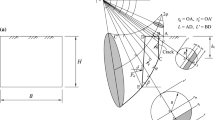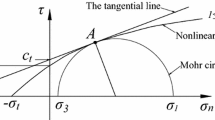Abstract
This work introduces a theoretical framework for determining the active non-limit earth pressure of cohesive soil on a base-rotating rigid wall. The framework incorporates the nonlinear Mohr–Coulomb failure criterion, the Duncan–Chang hyperbolic stress–strain relationship, the log-spiral potential failure surface in retained soil, and a horizontal slice method for the earth pressure evaluation. The proposed method allows quantitative determination of displacement-dependent earth pressure and its distribution along the wall back. Practical wall movement in the at-rest state is considered, and the tension crack depth near the soil surface is calculated based on the soil tensile strength cut-off. Analysis results highlight the nonlinear variation of the mobilized soil shear strength vertically, influenced by the nonlinear Mohr–Coulomb failure criterion. As the wall rotation increases, the earth pressure follows a convex parabolic distribution with a tension failure zone near the soil surface and no pressure at the wall base. The resultant of the earth pressure reduces and its application point descends while the tension crack depth expands, though always remaining less than the Rankine’s earth pressure. A practical example shows that the at-rest earth pressure can be up to 1.3 times greater than the active earth pressure, with the resultant application point approximately 5% higher. Parameter study exhibits that the active non-limit earth pressure correlates nonlinearly with the soil ultimate tensile stress and nonlinear coefficient, particularly as wall movement increases. Active non-limit earth pressures vary within 86% across different soil cohesions, and up to 50% under varying ultimate tensile stresses and nonlinear coefficients. Overturning safety factors of the wall in the active non-limit state differ significantly from those in the at-rest state, especially under varying soil cohesions.
























Similar content being viewed by others
Data Availability
All data generated or analysed during this study are included within the article.
References
Ehrlich M, Silva RC (2015) Behavior of a 31 m high excavation supported by anchoring and nailing in residual soil of gneiss. Eng Geol 191:48–60. https://doi.org/10.1016/j.enggeo.2015.01.028
Matsuzawa H, Hazarika H (1996) Analyses of active earth pressure against rigid retaining wall subjected to different modes of movement. Soils Found 36(3):51–65. https://doi.org/10.3208/sandf.36.3_51
Paik KH, Salgado R (2003) Estimation of active earth pressure against rigid retaining walls considering arching effects. Geotechnique 53(7):643–653. https://doi.org/10.1680/geot.2003.53.7.643
Coulomb CA (1776) Essai sur une application des regles de maximis et minmis a quelques problemes de statique, relatifs a l’architecture. Memoires de Mathematique et de Physique 7:343–382
Rankine WJ (1857) On the stability of loose earth. Philos Trans R Soc Lond 147:9–27
Sun YJ, Song EX (2016) Active earth pressure analysis based on normal stress distribution function along failure surface in soil obeying nonlinear failure criterion. Acta Geotech 11(2):255–268. https://doi.org/10.1007/s11440-015-0390-z
Bishop AW, Webb DL, Lewin PI (1965) Undisturbed samples of London clay from the Ashford common shaft: strength-effective stress relationships. Geotechnique 15(1):1–31. https://doi.org/10.1680/geot.1965.15.1.1
Day RW, Axten GW (1989) Surficial stability of compacted clay slopes. J Geotech Eng 115(4):577–580. https://doi.org/10.1061/(ASCE)0733-9410(1989)115:4(577)
Baker R (2004) Nonlinear Mohr envelopes based on triaxial data. J Geotechn Geoenviron Eng 130(5):498–506. https://doi.org/10.1061/(ASCE)1090-0241(2004)130:5(498)
Zhao LH, Cheng X, Dan HC et al (2017) Effect of the vertical earthquake component on permanent seismic displacement of soil slopes based on the nonlinear Mohr-Coulomb failure criterion. Soils Found 57(2):237–251. https://doi.org/10.1016/j.sandf.2016.12.002
Zhang XJ, Chen WF (1987) Stability analysis of slopes with general nonlinear failure criterion. Int J Numer Anal Meth Geomech 11(1):33–50. https://doi.org/10.1002/nag.1610110104
Drescher A, Christopoulos C (2010) Limit analysis slope stability with nonlinear yield condition. Int J Numer Anal Meth Geomech 12(3):341–345. https://doi.org/10.1002/nag.1610120307
Baker R, Frydman S (1983) Upper bound limit analysis of soil with non-linear failure criterion. Soils Found 23(4):34–42. https://doi.org/10.3208/sandf1972.23.4_34
Yang XL, Yin JH (2004) Slope stability analysis with nonlinear failure criterion. J Eng Mech 130(3):267–273. https://doi.org/10.1061/(ASCE)0733-9399(2004)130:3(267)
Terzaghi K (1934) Large retaining wall tests. Eng News-Rec 112:136–140
Fang YS, Chen JM, Chen CY (1997) Earth pressures with sloping backfill. J Geotech Geoenviron Eng 123(3):250–259. https://doi.org/10.1061/(ASCE)1090-0241(1997)123:3(250)
Mei GX, Chen R, Liu J (2017) New insight into developing mathematical models for predicting deformation-dependent lateral earth pressure. Int J Geomech 17(8):06017003. https://doi.org/10.1061/(ASCE)GM.1943-5622.0000902
Shamsabadi A, Rollins KM, Kapuskar M (2007) Nonlinear soil-abutment-bridge structure interaction for seismic performance-based design. J Geotech Geoenviron Eng 133(6):707–720. https://doi.org/10.1061/(ASCE)1090-0241(2007)133:6(707)
Yue ZR, Peng YZ, Zhang SD (1992) Centrifuge model tests on lateral pressure on walls retaining compacted clayey backfill. Chin J Geotech Eng 14(6):90–96 (in Chinese)
Duncan JM, Mokwa RL (2001) Passive earth pressures: theories and tests. J Geotech Geoenviron Eng 127(3):248–257. https://doi.org/10.1061/(ASCE)1090-0241(2001)127:3(248)
Yang TH, He HJ, Gong XC (2012) Analysis again for earth pressure calculation theory considering displacement effects. Adv Mater Res 368:2755–2759. https://doi.org/10.4028/www.scientific.net/AMR.368-373.2755
Mei GX, Chen QM, Song LH (2009) Model for predicting displacement-dependent lateral earth pressure. Can Geotech J 46(8):969–975. https://doi.org/10.1139/T09-040
Ni PP, Mangalathu S, Song LH et al (2018) Displacement-dependent lateral earth pressure models. J Eng Mech 144(6):04018032. https://doi.org/10.1061/(ASCE)EM.1943-7889.0001451
Chen L (2014) Active earth pressure of retaining wall considering wall movement. Eur J Environ Civ Eng 18(8):910–926. https://doi.org/10.1080/19648189.2014.911121
Donald IB, Chen ZY (1997) Slope stability analysis by the upper bound approach: fundamentals and methods. Can Geotech J 34(6):853–862. https://doi.org/10.1139/t97-061
Bang S (1985) Active earth pressure behind retaining walls. J Geotech Eng 111(3):407–412. https://doi.org/10.1061/(ASCE)0733-9410(1985)111:3(407)
Chang MF (1997) Lateral earth pressures behind rotating walls. Can Geotech J 34(4):498–509. https://doi.org/10.1139/t97-016
Zhang ZX, Li YG, Tian C (2015) Study on the calculation method of earth pressure on retaining wall in the mode of translation. Adv Mater Res 1089:292–298. https://doi.org/10.4028/www.scientific.net/AMR.1089.292
Xie T, Luo Q (2018) Macroscopic embodiment of stress-strain behavior of backfill soil on the displacement-dependent earth pressure curve. Int J Geomech 18(12):04018178. https://doi.org/10.1061/(ASCE)GM.1943-5622.0001327
Luo W, Li JB, Tang GP et al (2021) Upper-bound limit analysis for slope stability based on modified Mohr-Coulomb failure criterion with tensile cutoff. Int J Geomech 21(10):04021184. https://doi.org/10.1061/(ASCE)GM.1943-5622.0002154
Gipprich TL, Snieder RK, Jibson RW et al (2008) The role of shear and tensile failure in dynamically triggered landslides. Geophys J Int 172(2):770–778. https://doi.org/10.1111/j.1365-246X.2007.03681.x
Sawada T, Chen WF, Nomachi SG (1993) Assessment of seismic displacements of slopes. Soil Dyn Earthq Eng 12(6):357–362. https://doi.org/10.1016/0267-7261(93)90038-S
Zornberg JG, Sitar N, Mitchell JK (1998) Performance of geosynthetic reinforced slopes at failure. J Geotech Geoenviron Eng 124(8):670–683. https://doi.org/10.1061/(ASCE)1090-0241(1998)124:8(670)
Xiao SG, Yan YP, Xia P (2021) General solution for active earth pressure on rigid walls under strip surcharge on retained soils using variational method. Int J Civ Eng 19:881–896. https://doi.org/10.1007/s40999-020-00579-4
Chen WF (1975) Limit analysis and soil plasticity. Elsevier Scientific Publishing Co, New York
Soubra AH, Macuh B (2002) Active and passive earth pressure coefficients by a kinematical approach. Geotech Eng 155(2):119–131. https://doi.org/10.1680/geng.2002.155.2.119
Wang L, Xiao SG (2021) Calculation method for displacement-dependent earth pressure on a rigid wall rotating around its base. Int J Geomech 21(8):04021132. https://doi.org/10.1061/(ASCE)GM.1943-5622.0002104
Tejchman J, Wu W (2009) FE-investigation of shear localization in granular bodies under high shear rate. Granul Matter 11:115–128. https://doi.org/10.1007/s10035-009-0128-4
Widuliński Ł, Tejchman J, Kozicki J et al (2011) Discrete simulations of shear zone patterning in sand in earth pressure problems of a retaining wall. Int J Solids Struct 48(7–8):1191–1209. https://doi.org/10.1016/j.ijsolstr.2011.01.005
Hegert H, Hettler A (2019) Numerische simulation des erdwiderstands für sand und vergleich mit messergebnissen aus modellversuchen. Geotechnic 42(4):187–198. https://doi.org/10.1002/gete.201900014. (in German)
Patel S, Deb K (2020) Study of active earth pressure behind a vertical retaining wall subjected to rotation about the base. Int J Geomech 20(4):04020028
Benmebarek N, Labdi H, Benmebarek S (2016) A numerical study of the active earth pressure on a rigid retaining wall for various modes of movements. Soil Mech Found Eng 53(1):39–45. https://doi.org/10.1007/s11204-016-9362-z
Loukidis D, Salgado R (2012) Active pressure on gravity walls supporting purely frictional soils. Can Geotech J 49(1):78–97. https://doi.org/10.1139/t11-087
Kondner RL (1963) Hyperbolic stress-strain response: cohesive soils. J Soil Mech Found Div 89(1):115–143. https://doi.org/10.1061/JSFEAQ.0000479
Duncan JM, Chang CY (1970) Nonlinear analysis of stress and strain in soils. J Geotech Eng Div 96(5):1629–1653. https://doi.org/10.1061/JSFEAQ.0001458
Tatsuoka F, Siddiquee MS, Park CS et al (1993) Modelling stress-strain relations of sand. Soils Found 33(2):60–81. https://doi.org/10.3208/sandf1972.33.2_60
Sherif MA, Fang YS, Sherif RI (1984) KA and K0 behind rotating and non-yielding walls. J Geotech Eng 110(1):41–56. https://doi.org/10.1061/(ASCE)0733-9410(1984)110:1(41)
Handy RL (1985) The arch in soil arching. J Geotech Eng 111(3):302–318. https://doi.org/10.1061/(ASCE)0733-9410(1985)111:3(302)
Federico A, Elia G, Germano V (2008) A short note on the earth pressure and mobilized angle of internal friction in one-dimensional compression of soils. J Geotech Eng 3(1):41–46. https://doi.org/10.6310/jog.2008.3(1).5
Michalowski R (2017) Stability of intact slopes with tensile strength cut-off. Géotechnique 67(8):720–727. https://doi.org/10.1680/jgeot.16.P.037
The MathWorks Inc (2018) Global optimization toolbox: user’s guide (R2018b). Retrieved September. http://www.mathworks.com/help/pdfdoc/gads/gadstb.pdf. Accessed 10 Nov 2018
Callisto L, Calabresi G (1998) Mechanical behaviour of a natural soft clay. Géotechnique 48(4):495–513. https://doi.org/10.1680/geot.1998.48.4.495
Peng MX, Chen J (2013) Slip-line solution to active earth pressure on retaining walls. Géotechnique 63(12):1008–1019. https://doi.org/10.1680/geot.11.P.135
Rao PP, Chen QS, Zhou YT et al (2016) Determination of active earth pressure on rigid retaining wall considering arching effect in cohesive backfill soil. Int J Geomech 16(3):04015082. https://doi.org/10.1061/(ASCE)GM.1943-5622.0000589
Irdmoosa KG, Shahir H (2019) Analytical solution for active earth pressure of c–φ soil considering arching effect. Geomech Geoeng 14(2):71–84. https://doi.org/10.1080/17486025.2018.1533649
Clough G, Duncan J (1991) Chapter 6: Earth pressures. In: Fang H-Y (ed) Foundation engineering handbook. Springer, New York, pp 223–235
Becker DE, Moore ID (2006) Canadian foundation engineering manual. Canadian Geotechnical Society Alliston, Canada
Li ZW, Yang XL (2019) Active earth thrust considering tension crack, pore-water pressure and soil nonlinearity. KSCE J Civ Eng 23(1):56–62
Acknowledgements
This research was supported by the National Natural Science Foundation of China (Grant No. 51578466) and Construction S&T Project of Department of Transportation of Sichuan Province (Grant No. 2020A01).
Author information
Authors and Affiliations
Corresponding author
Ethics declarations
Conflict of Interest
The authors declare that they have no conflict of interest.
Rights and permissions
Springer Nature or its licensor (e.g. a society or other partner) holds exclusive rights to this article under a publishing agreement with the author(s) or other rightsholder(s); author self-archiving of the accepted manuscript version of this article is solely governed by the terms of such publishing agreement and applicable law.
About this article
Cite this article
Wang, L., Xiao, S. Calculation Method for Active Non-limit Earth Pressure of Cohesive Soil on a Rigid Wall Based on the Nonlinear Mohr–Coulomb Failure Criterion. Int J Civ Eng (2024). https://doi.org/10.1007/s40999-024-00948-3
Received:
Revised:
Accepted:
Published:
DOI: https://doi.org/10.1007/s40999-024-00948-3




